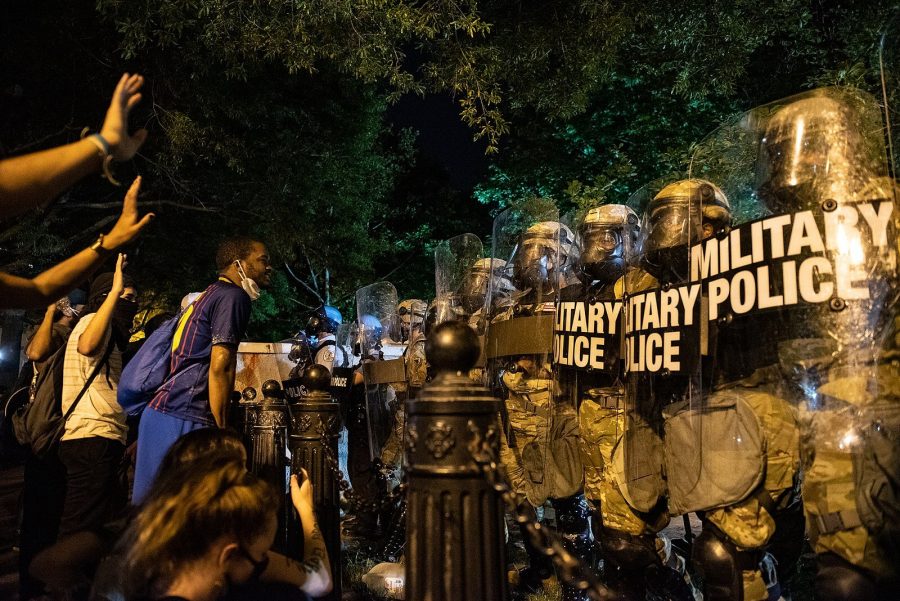Police’s use of rubber bullets and tear gas put protestors at risk of severe injuries
June 20, 2020
Protesters marched through downtown Columbus, Ohio to protest against racial inequality and the police’s treatment of people of color on May 28. Similar to many demonstrations across the country, the police officers on duty used rubber bullets, tear gas and pepper spray to control the crowd of protesters.
Two days after the rally, 22-year-old Sarah Grossman, a protestor at the demonstration, was found unresponsive in her home and eventually died only a few hours later at a local hospital. While the cause of Grossman’s death is still unknown, many on social media have speculated this sudden tragedy may have been due to her exposure to pepper spray and tear gas used by the police a few nights prior.
Now, activists and health officials are issuing warnings about the dangers of “non-lethal” crowd control weapons used by law enforcement towards protesters, some even calling for them to be outlawed.
In the weeks following the murder of George Floyd, the number of protests in all 50 states in America has grown exponentially. This increase has been paralleled by the growing number of injuries at protests caused by the local police’s use of riot control agents to restrain protesters and force them to disperse.
The weapon that has gained the most notoriety during the ongoing protests has been rubber bullets. At protests in several of America’s biggest cities, police officers have shot out rounds of rubber bullets into crowds to cause disarray and dispersal of large crowds.
The use of the weapon has received massive backlash due to media reports and personal accounts from protesters claiming they suffered severe injuries such as vision loss, concussions and internal bleeding.
Rubber bullets are a threat to all demonstrators attending protests due to their composition and the lack of regulation on the police’s use of them.
While rubber bullets, sometimes referred to as “kinetic impact projectiles,” are supposed to be made up of rubber, some that are being used by police at protests currently do not meet that standard. Most of the rubber bullets utilized by law enforcement at protests have a metal core and are composed of materials such as plastic, hardened foam and wood.
When the dangerous composition of the bullets is paired with the speed in which they are fired, they could permanently damage or kill anyone it comes in contact with.
“At short range, they come out of the gun as fast as a bullet,” Rohini Haar, a physician and expert for Physicians for Human Rights, said.
“And so they can break bones. They can fracture skulls. If they hit the face, they can cause permanent damage and disability. At long distances, they ricochet, they have unpredicted trajectories, they bounce, and they’re quite indiscriminate. So they can’t possibly target either an individual or a safe body part of an individual.”
The dangers of rubber bullets are magnified by the absence of any national standard or rule on when law enforcement is permitted to use the weaponry at a demonstration.
“Police are not required to document their use of rubber bullets, so there is no national data to show how often they’re used,” according to CNN.
However, a review paper published in the BMJ by the International Network of Civil Liberties Organizations and Physicians for Human Rights in 2017 found that 15% of nearly 2,000 reported injuries caused by projectiles classified as rubber bullets around the world resulted in a permanent disability and 3% resulted in death.
Tear gas and pepper spray have also been extensively implemented by local law enforcement officers in the United States and across the globe as another method of crowd control. Footage from protests have proven police officers do not hesitate to spray demonstrators with these chemicals, even if they are protesting peacefully.
In one video that went viral, an officer pulled down the mask of a protester with his arms up in the air to pepper spray him. In another viral video, a young child at a Seattle protest was also pepper sprayed and was in obvious discomfort.
While tear gas and pepper spray are known to cause immediate discomfort to the eyes and lungs of whoever encounters it, the most dangerous aspect of its use is the ambiguity around its long-term effects.
“It’s still questionable what kinds of respiratory damage tear gas does,” said Anna Feigenbaum, author of Tear Gas: From the Battlefields of World War I to the Streets of Today.
“What we do know is that for people who have any kind of preconditions, it’s incredibly dangerous for them to be in spaces that are tear-gassed. For anyone who’s very young or very old, it has increased dangers.”
As rallies continue to go on around the world with demonstrators continuing to record their injuries caused by crowd control weapons on social media, protesters and activists are beginning to call for changes to the way police officers handle crowds.
“The violence we have seen from police forces across the U.S. has been appalling and must be condemned in the strongest possible terms,” Andrew Smith, media coordinator of Campaign Against Arms Trade, said.
Non-profit organization Physicians for Human Rights is another group calling for an urgent change to the way law enforcement deals with large crowds of protesters and a widespread ban on the use of rubber bullets.
“Rubber bullets are used almost every day somewhere in the world,” Rohini Haar said. “Using them against unarmed civilians is a huge violation of human rights.“








